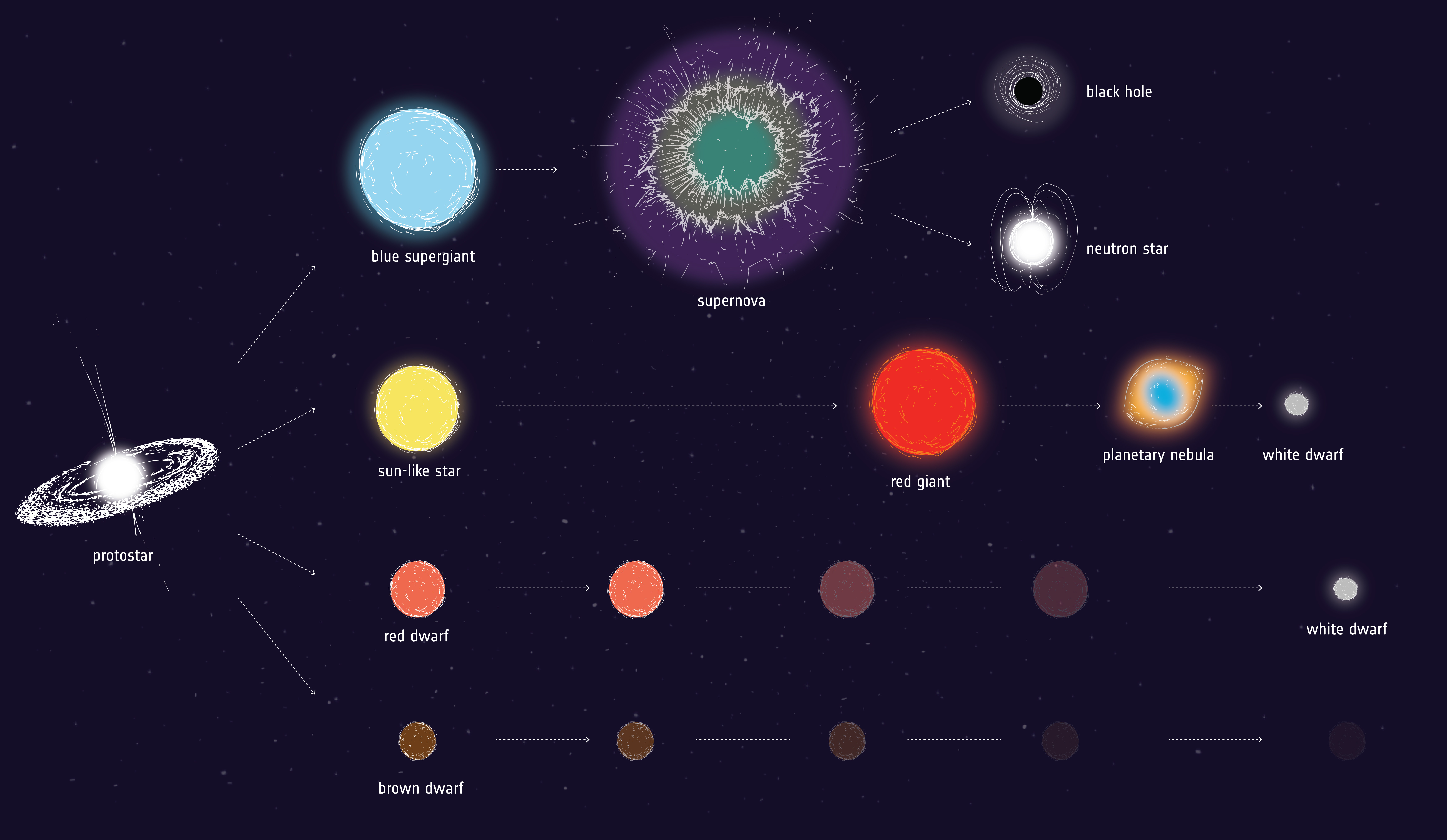Stellar Evolution
Stellar evolution is the description of the way that stars change with time. On human timescales, most stars do not appear to change at all, but if we were to look for billions of years, we would see how stars are born, how they age and how they die.
The primary factor determining how a star evolves is its mass as it reaches main sequence. The following is a brief outline tracing the evolution of a low-mass and a high-mass star. (Pic Credits: ESA)

Life of a Star
- Stars are born out of the gravitational collapse of cool, dense molecular clouds. As the cloud collapses, it fragments into smaller regions, which themselves contract to form stellar cores. These protostars rotate faster and increase in temperature as they condense, and are surrounded by a protoplanetary disk out of which planets may later form.
- The central temperature of the contracting protostar increases to the point ehere nuclear reactions begin. At this point, hydrigen is converted into helium in the core and the star is born onto the main sequence. For about 90% of its life, the star will continue to burn hydrogen into helium and will remain a main sequence star.
- Once the hydrogen in the core has all been burned into helium, energy generation stops and the core begins to contract. This raises the internal temperature of the star and ignites a shell of hydrogen burning around the inert core. Meanwhile, the helium core continues to contract and increase in temperature, which leads to an increased energy generation rate in the hydrogen shell. This causes the star to expand enormously and increase in luminosity - the star becomes a red giant.
- Eventually, the core reached temperatures high enough to burn helium into carbon. If the mass of the star is less than 2.2 solar masses, the entire core ignites suddently in a helium core flash. If the star is more massive than this, the ignition of the core is more gentle. At the same time, the star continues to burn hydrogen in a shell around the core.
- The star burns helium into carbon in its core for a much shorter time than it burned hydrogen. Once the helium has all been converted, the inert carbon core begins to contract and increase in temperature. Tgus ugnites a helium burning shell just above the core, which in turn is surrounded bu a hydrogen burning shell.
What next?
What happens next depends on the mass of the star.
Less than 8 Solar masses:
- The inert carbon core continues to contract but never reaches temperatures sufficient to initiate carbon burning. However, the existence of two burning shells leads to a thermally unstable situation in which hydrogen and helium burning occur out of phase with each other. This thermal pulsing is characteristic of asymptotic giant branch stars.
- The carbon core continues to contract until it is supported by electron degeneracy pressure. No further contraction is possible (the core is now supported by the pressure of electrons, not gas pressure), and the core has formed a white dwarf. Meanwhile, each thermal pulse causes the outer layers of the star to expand, resulting in a period of mass loss. Eventually, the outer layers of the star are ejected completely and ionised by the white dwarf to form a planetary nebula.
Greater than 8 Solar masses:
- The contracting core will reach the temperature for carbon ignition, and begin to burn to neon. This process of core burning followed by core contraction and shell burning, is repeated in a series of nuclear reactions producing successively heavier elements until iron is formed in the core.
- Iron cannot be burned to heavier elements as this reaction does not generate energy - it requires an input of energy to proceed. The star has therefore finally run out of fuel and collapses under its own gravity.
- The mass of the core of the star dictates what happens next. If the core has a mass less than about 3 times that of our Sun, the collapse of the core may be halted by the pressure of neutrons (this is an even more extreme state than the electron pressure that supports white dwarfs!). In this case, the core becomes a neutron star. The sudden halt in the contraction of the core produces a shock wave which propagates back out through the outer layers of the star, blowing it apart in a core-collapse supernova explosion. If the core has a mass greater than about 3 solar masses, even neutron pressure is not sufficient to withstand gravity, and it will collapse further into a stellar black hole.
- The ejected gas expands into the interstellar medium, enriching it with all the elements synthesised during the star’s lifetime and in the explosion itself. These supernova remnants are the chemical distribution centres of the Universe.